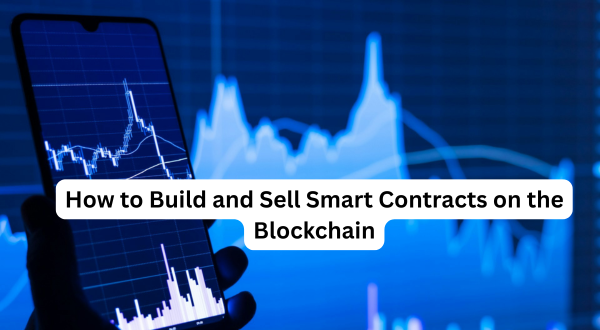The blockchain revolution has opened up a world of new opportunities for developers, entrepreneurs, and businesses. Among these opportunities is the ability to create and sell smart contracts—self-executing contracts with the terms of the agreement directly written into code. These contracts are essential to decentralized applications (dApps) and can be used in various industries like finance, real estate, and supply chain management.
In this guide, we’ll walk you through how to build and sell smart contracts on the blockchain, from setting up your development environment to monetizing your creations.
What is a Smart Contract?
A smart contract is a program that runs on a blockchain, automatically executing and enforcing the terms of an agreement when certain conditions are met. These contracts are transparent, secure, and tamper-proof, making them ideal for scenarios where trust, automation, and efficiency are important.
For example, in a simple smart contract, a buyer and seller could agree that a cryptocurrency payment will be automatically sent once the buyer confirms receipt of goods. The contract automatically checks the conditions and enforces the transaction.
Step 1: Learn the Basics of Blockchain and Smart Contracts
Before you can start building smart contracts, it’s important to have a solid understanding of blockchain technology, particularly how decentralized networks work. You should also learn the basics of Ethereum or other platforms that support smart contracts.
Ethereum is the most widely used platform for building smart contracts, but there are other blockchain networks that support them, such as Binance Smart Chain, Polkadot, and Solana.
Key concepts to learn:
- Blockchain basics: How decentralized networks operate, what a node is, and the idea of consensus mechanisms (e.g., Proof of Work, Proof of Stake).
- Ethereum: Learn about Ethereum’s smart contract platform, gas fees, and the Ethereum Virtual Machine (EVM).
- Solidity: The most common programming language used for writing smart contracts on the Ethereum blockchain.
Step 2: Set Up Your Development Environment
Once you have a basic understanding of blockchain and smart contracts, it’s time to set up your development environment. You’ll need the following tools:
- Node.js: A JavaScript runtime that will allow you to run Ethereum development frameworks.
- Truffle or Hardhat: These are Ethereum development frameworks that make it easier to develop, test, and deploy smart contracts.
- Metamask: A crypto wallet browser extension to interact with the Ethereum blockchain.
- Ganache: A personal blockchain for Ethereum development that you can use to test contracts locally.
- Solidity: The programming language for Ethereum smart contracts.
Installing Tools:
- Install Node.js: Visit the Node.js website to download and install it.
Install Truffle: Run the following command in your terminal:
npm install -g truffle
- Install Metamask: Download the Metamask extension for your browser.
- Install Ganache: You can download Ganache here.
Step 3: Write Your Smart Contract
Now that your development environment is ready, you can begin writing your smart contract. A simple contract in Solidity might look like this:
pragma solidity ^0.8.0;
contract SimpleStorage {
uint256 public storedData;
function set(uint256 x) public {
storedData = x;
}
function get() public view returns (uint256) {
return storedData;
}
}
In this example, the smart contract allows anyone to store a number on the blockchain and retrieve it later. The two functions set and get allow the contract’s data to be updated and read.
To deploy this contract, you’ll use Truffle or Hardhat to compile and deploy it to a test network like Rinkeby or Ropsten, or directly to the Ethereum mainnet (once you’re ready).
Step 4: Test Your Smart Contract
Testing your smart contract is crucial to ensure that it behaves as expected. Truffle and Hardhat provide testing environments where you can interact with your contract and check for any issues before deploying it to the mainnet.
Write tests using JavaScript or Solidity, depending on the framework you choose. Here’s a simple example using Truffle’s testing framework in JavaScript:
const SimpleStorage = artifacts.require(“SimpleStorage”);
contract(“SimpleStorage”, accounts => {
it(“should store a value”, async () => {
const instance = await SimpleStorage.deployed();
await instance.set(42, { from: accounts[0] });
const storedData = await instance.get();
assert.equal(storedData, 42, “The value wasn’t stored correctly.”);
});
});
Step 5: Deploy Your Smart Contract
Once your smart contract is tested and ready, you can deploy it to a live blockchain. This step requires paying gas fees, which are paid in Ethereum (ETH). You can deploy your contract using Truffle or Hardhat to any Ethereum network—whether it’s a testnet for testing or the main Ethereum network for real-world applications.
To deploy using Truffle, follow these steps:
- Configure Truffle: In your truffle-config.js file, configure your network settings (e.g., Rinkeby or Mainnet).
Deploy the Contract: Run the following command to deploy your contract:
truffle migrate –network rinkeby
Step 6: Sell Your Smart Contract
Once your smart contract is deployed, you can sell it in several ways:
- Selling Code on Marketplaces: You can list your smart contract code on online marketplaces like OpenZeppelin, GitHub, or specialized blockchain development platforms where buyers are looking for pre-built solutions.
- Develop Custom Smart Contracts for Clients: Offer your smart contract development services to businesses looking to implement blockchain solutions. You can charge an hourly rate or a fixed price depending on the complexity of the contract.
- Create a SaaS Platform with Smart Contracts: Build a decentralized application (dApp) that leverages smart contracts and sell access to the platform, either through subscription models or transaction fees.
- Royalties for NFTs: If your smart contract is associated with NFTs, you can set up royalty payments so you receive a percentage every time an NFT is sold or transferred.
Conclusion
Building and selling smart contracts on the blockchain is an exciting way to capitalize on the growing demand for decentralized solutions. By learning the fundamentals of blockchain, choosing the right tools, and testing your contracts thoroughly, you can create valuable products that can generate income. Whether you’re developing bespoke contracts for clients, listing them on marketplaces, or launching your own dApp, the opportunities in blockchain technology are endless.
Start small, experiment, and keep learning—this is only the beginning of the blockchain revolution!
 UBUCH ubuch | Honest Tech Reviews & Tutorials for Everyone
UBUCH ubuch | Honest Tech Reviews & Tutorials for Everyone




